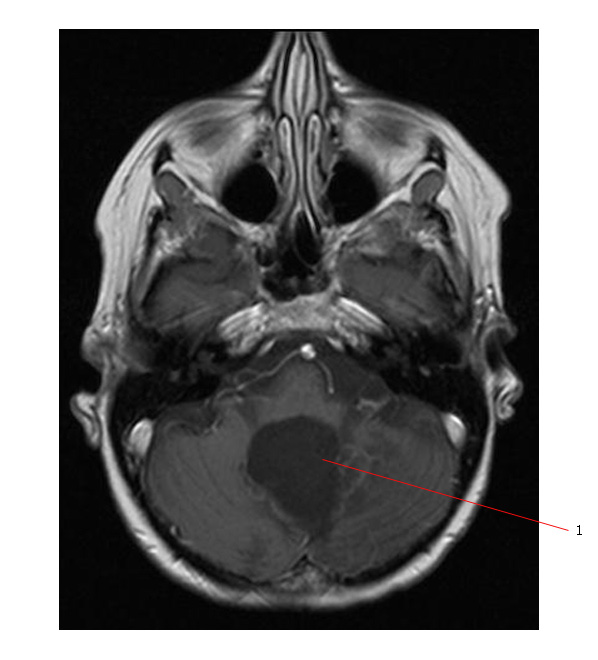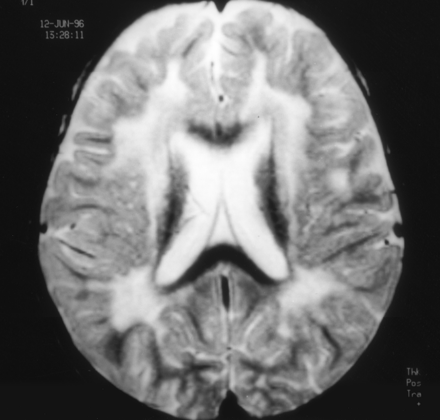Cranial RT
EARLY (during treatment and the first month after radiation)
Nausea and Vomiting
- Nausea and vomiting are very common and can be due not only to the RT, but concurrent chemotherapy
- Symptoms can be severe and prolonged
- Ondansetron (5-HT3 receptor antagonist) works well for RT induced nausea and should be given one hour to half an hour prior to therapy
Headache
- Due to initial transiently raised intracranial pressure when RT starts
- Dexamethasone is very helpful
Fatigue
- Common
Skin erythema
- Within the treatment field and dry desquamation
- Not a severe problem with 3D conformal RT
Alopecia
- Hair starts to fall out about 3 weeks after the start of RT (involves scalp receiving scattered RT) and grows back roughly 3 months later - depending on the total dose of RT given
EARLY DELAYED (up to 6 months after therapy)
Scattered astrocytic and microglial reactions, perivascular collections of mononuclear cells and demyelination seen.
- "Somnolence syndrome" possibly due to transient demyelination
- Starts 6 - 8 weeks after the end of therapy
- The somnolence syndrome lasts for about 2 weeks (there are no consistent CT changes and diffuse slow wave activity on the EEG).
- This side effect is more common in children having cranial RT for acute leukemia – possible relationship with methotrexate administration.
LATE (90 days to many years after therapy)
Many factors determine the severity of late effects. These include:
- Patient factors:
- Age at the time of RT
- Individual genetic and familial factors
- Disease factors:
- Region where tumor has arisen and RT sensitivity of the organ or part of organ that needs therapy
- Treatment factors:
- RT related
- Quality of the radiation
- Dose per fraction and total dose RT
- Volume of normal tissue irradiated
- Concurrent therapies received (surgery and chemotherapy).
- RT related
Several large studies of pediatric brain tumor survivors have shown long term neurologic, neurocognitive, endocrinologic, and neuropsychologic deficits.
Below is a summary of some late effects. A thorough summary of guidelines around management and surveillance as well as patient education can be found at www.survivorshipguidelines.org, published by the Children’s Oncology Group.
There is also a summary of CNS late effects given in the CNS Late effects section
General
- Permanent alopecia can occur in the region where the high dose RT was given (for example, alopecia involves the occipital region after posterior fossa boost treatment for medulloblastoma).
- Lens usually gets less than 15% of the cranial dose.
- Compared to matched sibling cohorts, survivors of pediatric brain neoplasms treated with RT are at an elevated risk for blindness in one or both eyes, cataracts and double vision.
Pituitary/Hypothalamus damage:
The pituitary gland is included in the treatment volume when the entire brain is irradiated. The degree of pituitary hormonal deficiency is related to the RT dose.
- Growth hormone production is the most sensitive to treatment.
- Threshold at 24 -29 Gy.
- Lower doses may produce isolated growth hormone deficiency and higher doses panhypopituitarism.
- Effect of RT on the pituitary axis is not immediate. Between 2 and 5 years after 30 Gy to the hypothalamic-pituitary axis 100% of children have biochemical growth hormone deficiency (this affects about 50% of children who receive 25 Gy cranial RT for ALL).
- Children who receive craniospinal radiation for medulloblastoma will require growth hormone replacement. Their height should be charted carefully on a growth velocity chart and when their growth starts to "fall off" a referral to an endocrinologist should be made.
- Delayed puberty and precocious puberty are both associated with cranial RT. This can occur with low doses associated with prophylactic cranial RT for ALL and affects girls more commonly than boys
Thyroid dysfunction and carcinoma:
- Cranial RT can cause primary hypothyroidism (scattered RT dose to thyroid) in addition to TSH deficiency.
- The thyroid is very sensitive to scattered RT and there is an increased risk of benign thyroid nodules after cranial RT and of low grade papillary thyroid cancer.
Second Malignancy
- See Secondary Neoplasm section.
Neurological Late Effects from High Dose RT
CNS complications
- Most likely due to a combination of direct injury to glial cells and damage to vasculature.
- Concurrent chemotherapy increases the risk of these complications.
- Sometimes severe cerebellar dysfunction can occur after posterior fossa RT.
- Very commonly children have learning and psychosocial problems (up to 90% of survivors). Analysis is difficult because of other factors such as raised intracranial pressure, surgery and infection. However much greater intellectual impairment has been found in children treated with RT for medulloblastoma vs. those treated with surgery only for cerebellar astrocytoma.
- Children less than 2 - 3 years old are much more likely to be significant learning disability after treatment. It is very likely that their IQ will be less than 70.
Below is a MR of a patient who has very significant cerebellar dysfunction after treatment for medulloblastoma. There are post-surgical changes (#1) and very severe cerebellar atrophy secondary to RT.

- Radiation to the posterior fossa significantly increases the risk of hearing deficits (direct damage to the cochlea)
- Related also to cisplatin chemotherapy (causes a sensorineural deafness) in combination with damage to the cochlea from RT.
- Injury to endothelial lining and subsequent proliferation of small blood vessels
- There is a significant increased incidence of cerebrovascular events (strokes – both hemorrhagic and thrombotic) many years after RT.
- Cerebral vessel angiography shows arterial wall irregularities and focal stenotic lesions.
- Arteritis can affect medium and large vessels.
- Accelerated atherosclerosis.
- Intracerebral cavernous malformations associated with cranial radiotherapy – within RT field associated with intracranial bleed.
- Radiation induced intracranial aneurysm can occur.
Necrotizing leukoencephalopathy:
- Involves diffuse reactive astrocytosis, demyelinization and multiple necrotic foci (no inflammation) that contain mineralized cellular debris.
- Patients often later develop cerebral atrophy and ventricular enlargement.
- Associated with combined radiation and chemotherapy to the CNS (IV & IT methotrexate, CNS RT of 20 Gy or more & CNS relapse of ALL).
- Clinical features are lethargy, seizures, spasticity, paresis and ataxia.
- Mineralizing microangiopathy may accompany this process and dystrophic calcification of CNS has been described in children who have died of ALL. The lenticular nucleus is always involved.
Below is a MR of RT induced leukoencephalopathy with diffuse white matter damage.

- Occurs in 0.1% - 1% of cases after 50 - 60 Gy in 200 cGy fractions. Above this dose the incidence increases quite rapidly.
- The risk increases with use of chemotherapy concurrently (especially with hydroxyurea).
- Occurs usually within 6 months to 5 years after RT (most 1 - 2 years later).
- Presents with signs of raised intracranial pressure and may have focal deficits.
- Radionecrosis appears as a mass lesion with surrounding edema on CT.
- Radionecrosis can be hard to differentiate from recurrent tumor. May need biopsy to differentiate the two. PET scanning may also be helpful. Radionecrosis is often progressive and fatal.
Below is a MR of radionecrosis (#1). The changes enhance with gadolinium and are difficult to distinguish from recurrent disease.

Long term survivors after RT for brain tumors are at significantly increased risk for a seizure disorder. Most likely due to:
- small vessel disease
- cerebral necrosis
- leukoencephalopathy
The brain develops rapidly up to 3 years of age and very little after the age of 5 to 6. The growth is due to an increase in the number of neurons as well as increase in size. RT significantly affects brain development early in life.
- The most significant factor which adversely affects quality of life in long term survivors after RT for pediatric brain tumors is the long-term neurocognitive disability induced by their treatment.
- IQ is decreased, there are learning and behavior difficulties leading to impaired school performance and social difficulties.
- These deficits are greater in those with whole brain irradiation than partial, and in younger children, particularly those under the age of 5.
- Performance skills are more affected than verbal skills.
There is a dose-response relationship for the long-term effects of RT and higher doses of RT increase the risk of significant intellectual problems.
- 50 - 60% of medulloblastoma patients had an IQ less than 70 in one study more than 5 years after completion of their therapy.
- There is a decrease in white matter over time after treatment for medulloblastoma.
- Decrease more rapid in patients having 3600 cGy v. 2340 cGy.
- There is a direct relationship between radiotherapy dose, age at diagnosis, IQ and volume of white matter.
The extent of damage secondary to RT is difficult to determine though - because of many variable factors - underlying disease (tumor type and location), presence of raised intracranial pressure, surgery and complications such as shunt infection, loss of time at school and depression.
- Damage to the cerebellum itself (and not just the cerebrum) may also affect IQ.
Second Neoplasm:
Summary of Late Effects secondary to Radiation Therapy (RT) in children:
| Late Effect | Inducing treatment |
Outcome |
Radiation Necrosis |
|
|
Necrotizing Leukoencephalopathy |
Combined CNS RT and chemotherapy
|
|
Mineralizing Microangiopathy |
Combined CNS RT and chemotherapy |
|
Intellectual Deficits |
Damage depends on:
|
|
Neuroendocrine Function |
Whole-brain RT or >30 Gy to the hypothalamic pituitary axis |
|
RT and chemotherapy |
|

